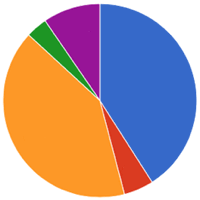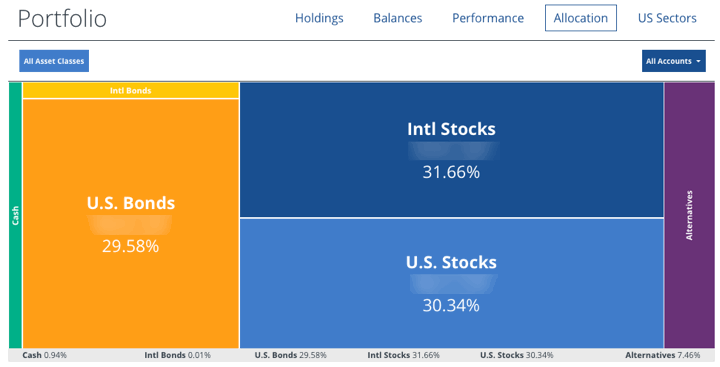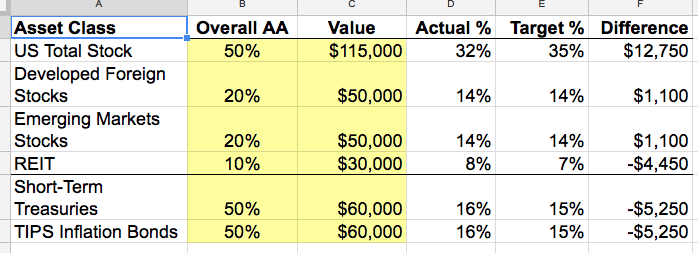 Here’s a reader question regarding my most recent portfolio asset allocation update. It has been edited for clarity and to remove personal details by request:
Here’s a reader question regarding my most recent portfolio asset allocation update. It has been edited for clarity and to remove personal details by request:
Thank you for posting the quarterly finance updates. I would like to do something similar to track the returns by asset class but unfortunately, I have my funds across multiple accounts. Some of my funds are in Roth, Rollover IRA and a 401k from current employer. My wife has her funds in similar retirement accounts. How do I consolidate all my investment funds to get a holistic view and correct asset allocation? Also, how do I get Vanguard funds when my 401k options are limited?
First of all, everything may look neater in my updates, but I also have my funds spread across multiple accounts. My wife and I have funds spread across Roth IRA, Traditional IRA (at least temporarily), 401k/403b, Self-Employed 401(k), taxable brokerage accounts, savings bonds, and bank CDs.
Here are the details on how I do my quarterly update.

- I pull up my custom Google Spreadsheet and make a fresh duplicate of the most recent worksheet. I change the label to a brief datestamp so the labels aren’t too wide. “17.12” indicates December 2017, “1803” indicates March 2018, and so on. I keep all my old snapshots as tabs. This is handy because I can go back and remember what my portfolio looked like back in March 2009, for example.
- I log into each individual account one-by-one directly at the provider website. I could use an aggregator, but I do this just to make sure my addresses/passwords are correct in my trusty password manager and everything looks right. No new sub-accounts, no errors, new secure messages, etc. I pull up my holdings and type in the balances manually into the proper asset class cell. The spreadsheet adds them up.
- For most of my funds, the asset class is readily available. For example, I know that the Vanguard Emerging Markets Stock Index fund is going under “Emerging Markets”. If you aren’t sure or if the fund includes multiple asset classes (Target Retirement fund, LifeCycle fund, etc), you can either use a service like Personal Capital (free registration required) for a quick-and-easy analysis or Morningstar X-Ray (free TRP registration required) for a manual-but-deeper analysis.
- For the most part, the spreadsheet does the rest. The pie charts automatically update to show me my overall holistic breakdown. It shows me how far off I am from my target values, both in terms of percentage and dollar amounts.

When your 401k options are limited, here’s how I would pick the best choice available. I would start by narrowing it down to the cheapest index funds available. Look at all the expense ratios. These days, at least one should be under 0.30%. You can verify using the ticker symbol on Morningstar. For example, for a while my best 401k option was a proprietary S&P 500 index fund. So I bought that, and adjusted my holdings elsewhere. Later on, they added Vanguard Total International Stock index fund and a Schwab brokerage window. There are probably 10-15 other funds on the menu that I have no interest in owning. A Target fund might be the most reasonable choice. Remember to roll your 401k over to an IRA when you switch employers.
 The Best Credit Card Bonus Offers – 2025
The Best Credit Card Bonus Offers – 2025 Big List of Free Stocks from Brokerage Apps
Big List of Free Stocks from Brokerage Apps Best Interest Rates on Cash - 2025
Best Interest Rates on Cash - 2025 Free Credit Scores x 3 + Free Credit Monitoring
Free Credit Scores x 3 + Free Credit Monitoring Best No Fee 0% APR Balance Transfer Offers
Best No Fee 0% APR Balance Transfer Offers Little-Known Cellular Data Plans That Can Save Big Money
Little-Known Cellular Data Plans That Can Save Big Money How To Haggle Your Cable or Direct TV Bill
How To Haggle Your Cable or Direct TV Bill Big List of Free Consumer Data Reports (Credit, Rent, Work)
Big List of Free Consumer Data Reports (Credit, Rent, Work)
Just a note, I was using the morningstar tools @ TRowePrice by doing a free registration for years, but since beginning of this year TRowePrice does not have this tool for free accounts anymore.
Are you sure? I just used it yesterday and again today.
Strange.. my old free account I just could not get into the area. It always said sign up even though I was logged in. After your message I opened a new free account and in that account I can get to all the research areas just fine. I quickly added by info into the new account and I am set. Thanks again.
Hi Jonathan, I’ve been subscribing to your blog for 10 years and you’ve taught me quite a bit in that time! Question for you regarding that last sentence in this post: What are your thoughts about rolling an old 401k into your current 401k (instead of an IRA) for the benefit of retiring at age 55 and being able to access those funds penalty-free instead of waiting until age 59.5? This is assuming the current 401k offers good low-fee investment options.
I think that’s a fine idea, assuming your 401k has low-cost options. I have also rolled from 401k to 401k to avoid having pre-tax IRAs when I do the “Backdoor” Roth IRA (non-deductible IRA to Roth IRA).
Thanks!
Thank you Jonathan for the detailed write-up. Appreciate you posting the link to the spreadsheet as well.
Those with several accounts would indeed benefit to do something like this on at least an annual basis in order to get a sense of the overall asset allocation.
Now retired, when I worked my company 401k was through Vanguard. I had no say in that, no other choice. Since I like simplicity and efficiency, I eventually transferred all my Roth and traditional IRA’s there. I also had a brokerage account for “fun money”, and noticed that Vanguard lets you add “Outside Accounts” to your holdings. You enter what these holdings are, number of shares and where they are, and they get updated every day when the market closes. They also offer “Portfolio Watch”, where you can create sub-groups that you define, such as “Retirement Funds”, “All Assets”, etc, and they will provide asset class breakdowns by dollar value and percentage. They do all the work for me, and I love it!
You can access the Morningstar X-Ray tool here: http://www.morningstar.com/tools.html However, they now require you to create an account (there’s a free option) and make a portfolio, which will not automatically update. You have to enter the information manually.
I don’t mind looking up the info occasionally and entering it to compare across services. I also keep a spreadsheet but not anywhere as detailed.
My most recent understanding is that you can access Morningstar X-Ray for free via their iPad app, but you can no longer access it for free on the M* website, even with a free account. I was unable to access X-Ray without a Premium account as of 4/24/18.
Instant X-Ray is still available from M* website with free registration, which does not remember your portfolio once you leave the site. The T Rowe Price link I provided includes the “full” Portfolio X-Ray, which saves your portfolio between visits. The “full” X-Ray is now a premium features on the M* website.